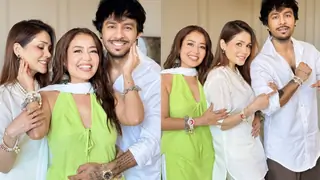A lot of people are want to know if the show is to be valued for its dramatic content or also for its social content. Members of this forum are debating whether SS and Shakti are caricatures or based in reality. Then again people want to know if the show can be looked to as a source of solutions for the evil it depicts, and if it is not the source of solutions, then what the possible solutions are. Since so much is being discussed I thought it would be worth our while to look at each of these questions somewhat in detail.
Drama or reality?
BOTH. The families, the context, the societies, the characters are all very much based on reality. On the other hand, the situations that these characters face, just like in life, are unique, and quite often dramatic. For instance, there are thousands of middle-class girls like Pratigya brought up with rigid 'sanskaars' and values. And several hundred Krishnas who roam small-town streets. But the possibility of a Pratigya marrying a Krishna is one in a thousand. But then interesting and unusually situations make for the more compelling narratives. If Pratigya had married Nitin as would have been the most probably situation, the show would have been a "Yeh rishta kya kehlata hai" which is alright in its space, but just not what these CVs intended.
So while the larger context is real, each individual situation may or may not be the most probable one.
Caricature or characters?
Are SS's and Shakti's evil propensities exaggerated? Unfortunately, the answer is NO. Like I said before, their situation is unusual because they have been lumped with an 'educated bahuriya', but in all the details of their vileness they are just very average representatives of a common type. Ammas and Kesars are dime a dozen in that world.
The Saxenas too are very much a type. The perfect example of middle-class morality, with their value for education, steadiness, good manners, respectability and integrity. Their fear of social ridicule and their slightly prudish ways are also typical.
The Mathurs too are based in pretty usual types, an upper-middle class family educated, sophisticated and upright for the most part. Sarweshwar Mathur is may be in a minority with regards to his incorruptible character, but he certainly does not belong in a set of one, as imagined by some of the diehard cynics. Even in India with its image of a corrupt system, principled men and women like Mathur do exists, and they do manage to make their impact. India maybe very far from perfect, but it is not hopeless.
Solutions or impractical ideas?
First of all are the CVs offering 'solutions'?
No, let us ask an even more basic question. Do we recognize a problem? Do the Thakurs (including KESAR), their mindset, and their moral ambiguity, represent a problem to us? Most of us would agree that they do.
For those who say 'yes there is a problem' - Is this problem a singularity or is it symptomatic of a larger social evil? The CVs have been at pains to tell us repeated that the Thakurs represent a whole social structure of 'Traditional Thakurayee' which involves, wresting power and wealth with gundas and guns, terrorizing the weak, and thouroughly subjugating the women in the household mentally and physically. So it is a very general problem that is prevalent in a section of a specific society/community.
I reapeat this point because it is very important for concerned viewers to understand that what is being depicted in this show is "SYSTEMIC ABUSE" in an entire strata of a specific society and NOT isolated/discrete cases of abuse as is the case with with societies in the west.
Like Krishna said when he was convincing his family to let Komal marry into the Saxenas, if she married into a Thakur family her fate would in all probability be exactly the same as Amma's, Kesar's and Ghanti dadi's. If anything Krishna is the anomaly, because he actually thinks before hitting his wife. This is also the reason that Krishna is so often humiliated in that household. A man in that community is EXPECTED to keep his wife in line by giving her a daily "prasaadi". A man who does not do this is considered weak. Therefore what we think of as "abuse" is part of the traditional mores of a certain society.
So far the CVs have depicted the problem. In specific they have 'viewed' this world through the eyes of an idealistic, horrified 'outsider' – namely Pratigya.
On certain occasions, when the situation has become untenable Pratigya has raised her voice against it. The police has been involved once. All this has gone towards creating a contrast between the attitudes of Kesar and Pratigya – both women married into the system, thereby challenging the mindset that prescribes complete obeisance and submission on the part of the woman.
Pratigya has not always won nor is she meant to. But she has unfailing raised her voice. That is the primary message. Almost everything that the show depicts in the case of conflict is that there are options for the woman apart from being victimised in silence.
There have been many suggestions about NGOs, social workers and homes for destitute women. But then taking one woman out of the set-up may be dramatically satisfying to anyone expecting quick-fix solutions but it is certainly not the answer. NGOs, and social workers help when a few hundred people need redressal. When a million people need an answer, the answer has to come from within. Traditional mores of can only be changed by changing the underlying mentality. Therefore these CVs (rightly IMO) attempt at challenging the mindset rather than feeling obliged to provide individual situational solutions on tap. Some resolution may even come (they will!), but it will come when the narrative is good and ready for it, it will come when the natural arc of the story comes to its climax. A story cannot have pit stops just to prove its moral rectitude on demand.
So the final point is this – While the entire arc of the story goes through the motions of depicting and evil in a realistic context and challenging the mentality that helps to perpetuate it, the story does not take on the erroneous and onerous task of providing pat and ready solutions to situations at every step. The attempt is to infuse ideas rather than prescribe specific courses of action.
The show will of course fulfill its primary obligation to entertain first!




























